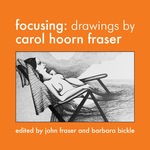About the Author: Carol Fraser
Carol Hoorn Fraser, (1930 – 1991), RCA, grew up in Superior, Wisconsin, and obtained an MFA at the University of Minnesota, where she studied under art historian Lorenz Eitner, aesthetician John Hospers, and poet Allen Tate, among others, wrote her thesis on "The Human Image in Contemporary Painting," and took top awards in major shows at the Walker Art Center and the Minneapolis Institute of Art. In 1961 she moved with her husband John to Halifax, Nova Scotia, where she lived until her death, with stays in Provence and Mexico. Her works are in the Walker Art Center, the Smithsonian Institute, the National Gallery of Canada, the Beaverbrook Art Gallery, and other public galleries.

Carol Hoorn Fraser, MFA, RCA (1930-1991) was a beautiful and unique American-born artist, who received a humanistic art education at the University of Minnesota, took first prizes in shows at the Walker Art Center and the Minneapolis Institute of Art, and lived for thirty years in Nova Scotia with her husband John, with stays in Provence and Mexico.
Like Sinatra, she did it her way, radically rethinking her popular expressionist style in the mid-Sixties and developing a decisive organicist iconography in oils that was all her own. Subsequently, when asthma became a problem, she embarked on a brilliant series of watercolours, returning to oils shortly before her death.
Her earlier drawings, of which she did a lot, were largely landscapes and explorations of bodily postures, nude and clothed. Later on, her drawings, much fewer now, were brilliantly expressive and personal, with women's experiences foregrounded—an unforgettable limp figure on a couch enduring migraine, a head strained upwards to receive a bitter pill (turn it sideways and she's a fury), the mouth as drama of exploratory tongue and teeth, a nude nesting contentedly amid forest birds.
Drawn from her later works, the twenty-seven images in Focussing are a master class in the imaginative possibilities of the medium, given by a virtuoso.
Her work is represented in numerous public collections, including the Walker Art Centre, the Smithsonian Institute, the National Gallery of Canada, and the Beaverbrook Art Gallery.
 Carol Hoorn Fraser, MFA, RCA (1930-1991) was a beautiful and unique American-born artist, who received a humanistic art education at the University of Minnesota, took first prizes in shows at the Walker Art Center and the Minneapolis Institute of Art, and lived for thirty years in Nova Scotia with her husband John, with stays in Provence and Mexico.
Carol Hoorn Fraser, MFA, RCA (1930-1991) was a beautiful and unique American-born artist, who received a humanistic art education at the University of Minnesota, took first prizes in shows at the Walker Art Center and the Minneapolis Institute of Art, and lived for thirty years in Nova Scotia with her husband John, with stays in Provence and Mexico.